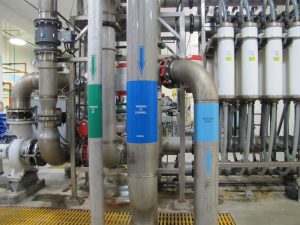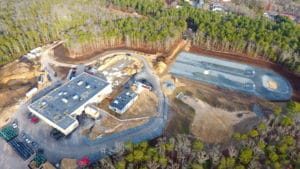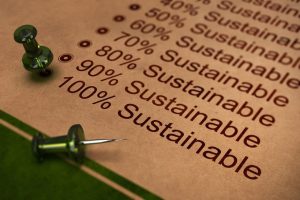 Municipal water treatment and distribution requires an exorbitant amount of resources, wreaking havoc on the environment and on budgets. And it’s getting worse. Over the past several years, operating costs have consistently been on the rise, while municipal budgets continue to shrink. In addition, regulatory requirements are increasing, forcing municipalities to upgrade treatment processes ahead of schedule. These changes result in limited unsustainable systems and utilities scrambling to find ways to manage their insufficient operational budgets while maintaining levels of service. The good news is that low-cost initiatives exist that can provide quick and significant cost and environmental savings and increase system sustainability.
Municipal water treatment and distribution requires an exorbitant amount of resources, wreaking havoc on the environment and on budgets. And it’s getting worse. Over the past several years, operating costs have consistently been on the rise, while municipal budgets continue to shrink. In addition, regulatory requirements are increasing, forcing municipalities to upgrade treatment processes ahead of schedule. These changes result in limited unsustainable systems and utilities scrambling to find ways to manage their insufficient operational budgets while maintaining levels of service. The good news is that low-cost initiatives exist that can provide quick and significant cost and environmental savings and increase system sustainability.
When incorporating sustainability into water systems, utilities consistently rank capital cost, life-cycle costs, and service lifetime as the top three considerations, while climate change and habitat protection are the lowest ranked factors. These statistics highlight the extreme fiscal challenges facing utilities today. While environmental factors are certainly important, water systems simply do not have the luxury to place them above financial concerns, as budgets are reaching a critical juncture. In short, cost drives decision-making. Fortunately, energy efficiency and sustainability result in a healthier environment, even when implemented primarily for cost-savings.

There are many technologies and practices that water systems employ to increase sustainability and energy efficiency, the most common of which is reducing non-revenue water (NRW). NRW includes real losses, the majority of which is the result of leaks in the distribution system. In fact, the United States loses about seven billion gallons of water every day to leaking pipes — enough to supply the nation’s ten largest cities with water — and this lost water puts a strain on supply, budgets, and the environment. Reducing NRW is most easily accomplished with a water audit, which helps water systems identify the causes and true costs of water loss, and develop strategies to reduce water loss and recapture lost revenue. Water audits are often the most cost-effective and efficient solution to increasing demand, and the return on investment of a water audit is typically less than one year. Effective water loss control programs reduce the need for facility upgrades and expansions as well as the need to find additional sources, while the recovered water helps systems to generate revenue and meet demand. In addition, an effective water loss control program protects public health by identifying the leaks from which disease‐causing pathogens can enter the system.
Other technologies and practices include educating customers on water conservation, source water protection planning, automated meter reading, and trenchless pipe repair, as well as energy audits. When water utilities decide to integrate sustainability and efficiency into their operations and infrastructure, the best place to start is with water loss. Water loss reduction initiatives tend to have a quick return on investment while providing significant cost and environmental savings. Once the effects of these savings are realized, implementing other green initiatives becomes more appealing and justifiable to management and water boards.

For new treatment plants, incorporating sustainability and efficiency features into the initial design allows the plant to function at a superior efficiency level right from the start. As an example, Tata & Howard provided design, permitting, and construction services for the new Dissolved Air Flotation (DAF) Long Pond Water Treatment Plant in Falmouth, MA. The project consisted of the construction of a new 8.0 mgd water treatment plant (WTP) for the existing Long Pond surface water supply. The existing Long Pond Pump Station, constructed in the 1890s, operated under a Filtration Waiver issued by the Massachusetts Department of Environmental Protection and did not include filtration processes to remove algae, organics, or particulates from the water. The new WTP provides the Town with several key benefits:
- Meets the current regulatory requirements of the Long Term 2 Enhanced Surface Water Treatment Rule;
- Reduces disinfection by-products and organics;
- Removes pathogens, taste, odor, and algae/algae toxins;
- Produces stable water quality;
- Provides the flexibility to meet uncertain future regulatory and water quality challenges.
In addition to providing a solution to the water challenges faced by the Town of Falmouth, the Long Pond WTP also provided more sustainable and efficient operations, saving the Town money while also protecting the environment. Some of these initiatives included the following:
- Recycling spent backwash water to head of plant and back into the treatment process, after it passes through a plate settler to remove solids;
- Recycling laboratory analyzer and filter influent piping gallery analyzer discharges back into the treatment process;
- Using filter-to-waste water after a filter backwash sequence as supply water for the next backwash, instead of using finished water for backwashing;
- Discharging cleaner supernatant water off the top of the lined lagoons to an unlined infiltration lagoon and back into the ground to minimize residuals;
- Use of local/native plants for landscaping, including an irrigation system using collected rainwater from roof drainage;
- Interior and exterior LED lighting fixtures; and
- Variable Frequency Drives (VFDs) on HVAC equipment and process equipment motors.
 Efficiency and sustainability are no longer considered luxuries for water systems. Rather, incorporating green initiatives into infrastructure design and operational standards has become crucial to the future sustainability of water systems. And while utilities today value cost-effectiveness over environmentalism due to the criticality of their budgets, there will likely be a shift in thinking as these systems ease the burden of their unsustainable operational costs through effective practices such as efficiency and water loss reduction.
Efficiency and sustainability are no longer considered luxuries for water systems. Rather, incorporating green initiatives into infrastructure design and operational standards has become crucial to the future sustainability of water systems. And while utilities today value cost-effectiveness over environmentalism due to the criticality of their budgets, there will likely be a shift in thinking as these systems ease the burden of their unsustainable operational costs through effective practices such as efficiency and water loss reduction.
